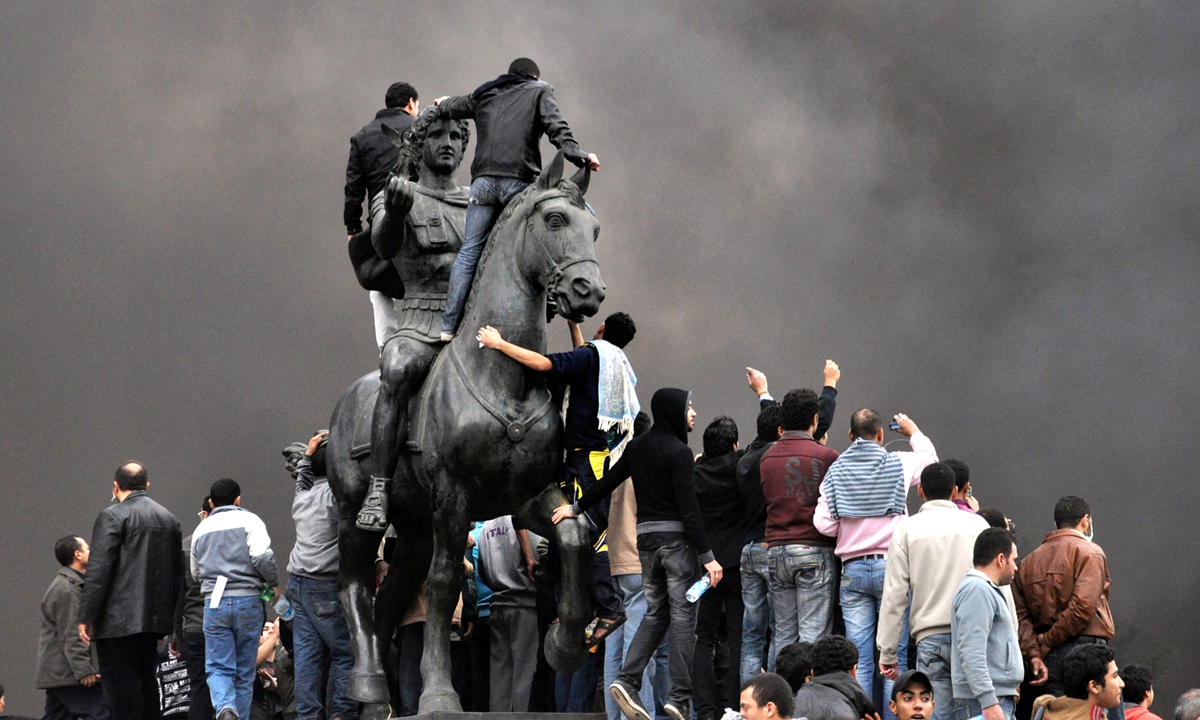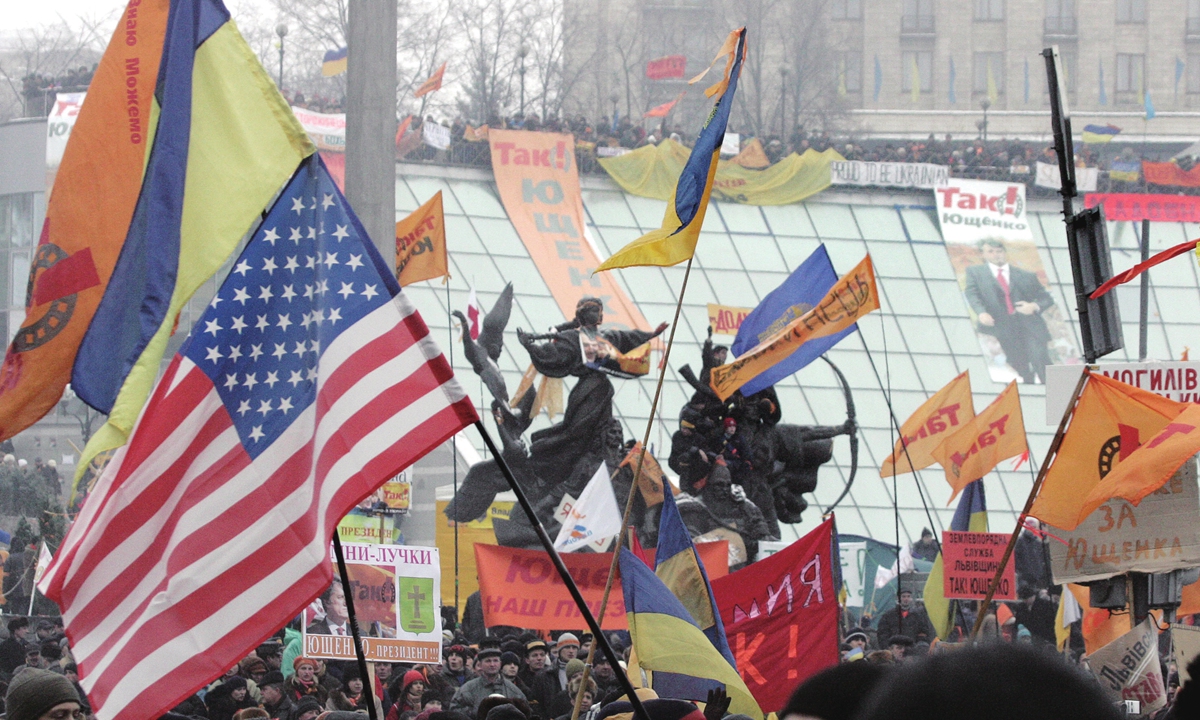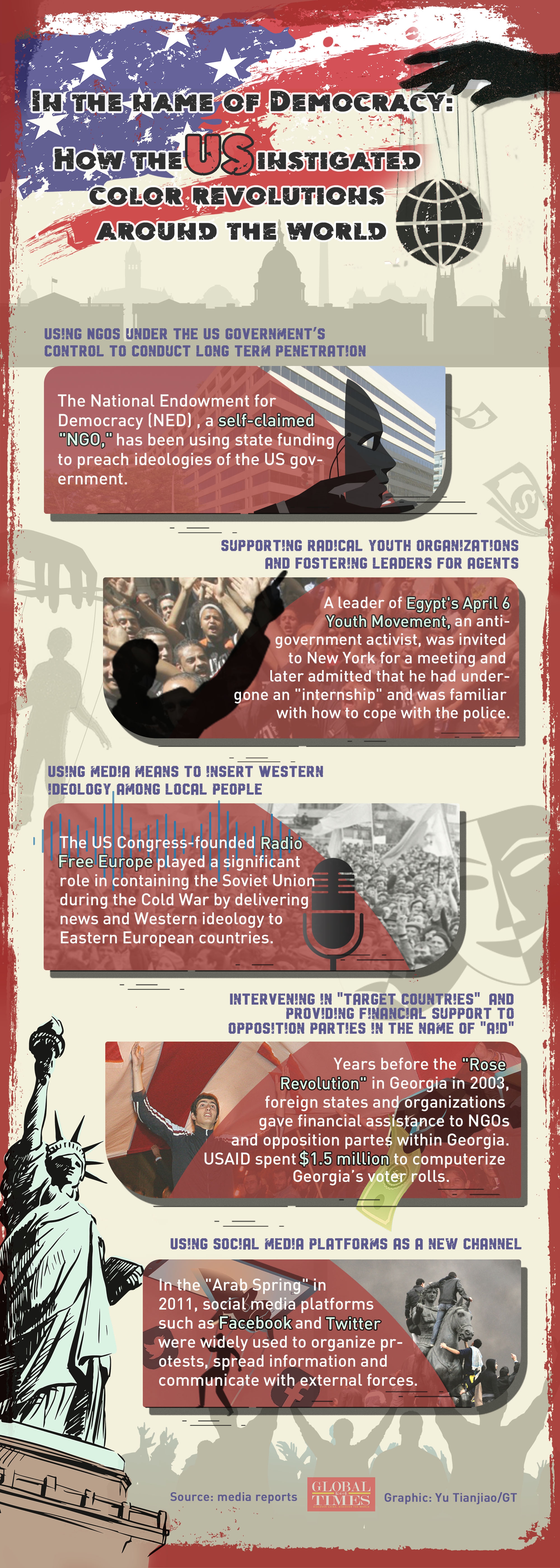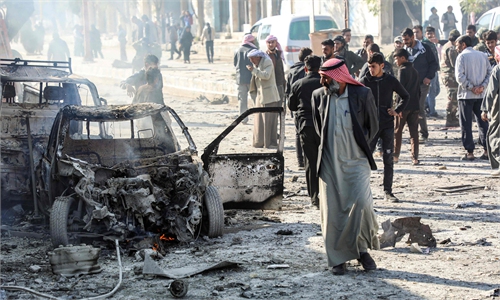GT Investigates: US wages global color revolutions to topple govts for the sake of American control
TRUE COLORS OF ‘DEMOCRACY’
How many evils have been committed in the name of democracy?
Exporting wars, launching "color revolutions," fomenting extremist ideologies, and promoting economic instability... the US has left endless trails of bloodshed and turmoil around the world. While the "model of democracy" loses its shine, the US still attempts to establish exclusive cliques through the so-called democracy summit. To expose the nature of "American democracy," the Global Times is publishing a series of articles to unmask the US' four democratic hegemonic sins. This is the second such piece.
The previous ones are: US war-mongering under guise of 'democracy' inflicts untold damage on the world; US cultivates pseudo-religious groups overseas, pumps support to terrorists to wreck its adversaries; US' wanton sanctions deal humanitarian disasters in countries it dislikes.

Egyptian protesters gather on the statue of Alexander the Great in Alexandria on January 28, 2011. Photo: AFP
To start a revolution, first you need to pick a color.Whether it is the "Rose Revolution" in Georgia in 2003, the "Orange Revolution" in Ukraine in 2004, the "Tulip Revolution" in Kyrgyzstan in 2005, or the "Arab Spring" in Asia and Africa in 2011, the past decades have seen the US plan and implement "color revolutions," or wars without gunpowder in many places around the world, frantically exporting "American values."
Instead of launching military operations directly in the name of "democracy," the US prefers to use color revolutions as a tool to intervene in other countries' internal affairs to subvert governments in order to reinforce its global control, which the US has found more efficient and economical.
It is estimated that in the past three decades, among all the toppled governments, those that were subverted by such "non-violent revolutions" accounted for more than 90 percent.
Before that, during the Cold War, the US engaged in 64 covert and six overt attempts at regime change, according to Covert Regime Change: America's Secret Cold War, by Lindsey A. O'Rourke.
However, what color revolutions left in their wake are neither peace nor Western democracy, but mass confusion, chaos, and destruction in the target countries.
It is the origin of the world's instability today, observers said.
Scourge on the world
Since late 20th century, color revolutions have swept through Central Asia, the former Soviet Union, and Eastern European countries.
Deeply digging into these color revolutions, behind the scenes, you are always likely to find the conspicuous black hands of the US.
Eurasian countries have been the worst-hit area by color revolutions where the US has been keen on inciting anti-government emotions and regime changes.
At the end of 2003, the US forced Eduard Shevardnadze, then president of Georgia, to resign on grounds of "fraud" in vote counting in parliamentary elections and supported the opposition leader Mikhail Saakashvili to be president. It is known as the "Rose Revolution."
Following Georgia, a similar scene played out in Ukraine in October 2004, as the US concocted a "fraud" scandal in Ukrainian elections and incited local youth to take to the streets and support the leader of the opposition, Viktor Yushchenko, who then was elected president. The event is known as the "Orange Revolution."
Once again in March 2005, the US drove Kyrgyzstan's opposition to protest against the results of the parliamentary elections, which eventually turned into riots. The "Tulip Revolution" ended with the President of Kyrgyzstan, Askar Akayev, abandoning power and fleeing.
In October 2020, Director of Russia's Foreign Intelligence Service Sergei Naryshkin accused the US of planning to start a "color revolution" in Moldova. Naryshkin pointed out in a statement that the US has brutally interfered in the internal affairs of Russia's neighboring countries.

Protesters clash with police in Cairo, Egypt on November 19, 2011. Photo: AFP
The US was also behind the "Arab Spring" uprisings in the Arab world, during which the wave of anti-government protests and violence led to civil wars in some countries and brought unrest and devastation to people there. The region has undergone major changes, but many countries were still reeling from the heavy blow dealt by the movement.
The color revolution has always closely worked alongside the US' global system of controlling the world, Zhang Shengjun, vice dean of the School of Political Science and International Relations at Beijing Normal University, told the Global Times on Wednesday.
In recent years, the US has turned its direction of applying color revolution tactics to countries and regions related to China in order to realize its purpose of containing the development of China, Zhang noted.
Textbook meddling case
The "color revolution" is not an impromptu performance orchestrated by an individual, but a deliberate political act. It is a coordinated action by planners, trainers, funders, instigators, troublemakers, followers, and occasionally, violent terrorists and even hired mercenaries.
Observers said that after decades of conducting color revolutions across the world, the US has developed a mature system of operation.
First, planners find a target they "dislike," after which they launch a psychological war. Usually they find and organize a group of political activists and provide them with information and financial support to intensify their opposition sentiment. Then, the planners help mobilize the masses to initiate political protests, including compelling nongovernmental organizations and the media to intervene or participate in the protest movement. Therefore, a chain of protests is set off with the planners just helping increase the intensity and expand the team to await the fall of the government.
There are some means that have frequently been adopted in color revolutions.
"NGOs" under the US government's control are often used to carry out long-term infiltration in targeted countries. The infamous National Endowment for Democracy (NED) of the US, a self-proclaimed "NGO" for instance, has been using state funding to preach the hegemonic doctrine of the US government. As of 2016, NED had provided some $96.52 million to at least 103 anti-China entities, including notorious separatist groups, such as the World Uyghur Congress (WUC) and the Tibetan Youth Congress (TYC).
The US has also been supporting radical youth organizations and fostering leaders for agents. A leader of Egypt's April 6 Youth Movement, an anti-government activist, was invited to New York for the International Coordination Meeting of Youth Organizations in 2008. He admitted later in a documentary that he had undergone an "internship" and was familiar with how to cope with the police.
The media is also used to implant Western ideologies among people. The US Congress-founded Radio Free Europe played a significant role in the containment of the Soviet Union during the Cold War through the delivery of news and transmission of Western ideologies to Eastern European countries. In 2019, it had received total funding to the tune of $124 million, broadcasting in 26 languages and reaching 37.6 million people every week.

An opposition supporter climbs up a giant Georgian national flag during a rally in central Tbilisi on November 2, 2007. Photo: AFP
In the name of aid, the US intervenes in the internal affairs of the "target country" and provides financial support to the country's opposition parties. Years before the "Rose Revolution" in Georgia in 2003, foreign states and organizations began to give financial assistance to NGOs and opposition parties within Georgia. USAID for instance, spent $1.5 million to computerize Georgia's voter rolls.Moreover, some protests during the color revolution, including members of opposition organization Otpor! in the 2004 Ukrainian revolution, "practically used a textbook" in lectures, which is the notorious From Dictatorship to Democracy by Gene Sharp, known as the guru of nonviolence, according to media reports. The Albert Einstein Institution founded by Sharp is also allegedly funded by NED.
The purpose of the US inciting color revolutions abroad is to overthrow powerful anti-America regimes and cultivate pro-America ones in their stead, said Song Quancheng, head of the Institute of Migration Studies at Shandong University.
A favorite trick of the US is to depict and mold the image of an anti-US or anti-NATO regime as a dictatorial regime that "poses a serious threat to the human rights of its people," and intervenes under the guise of "averting a humanitarian disaster," Song pointed out.
Meanwhile, the means of color revolution has been insistently improving to be more effective.
In the "Arab Spring" of 2011, social media networks such as Facebook and Twitter were widely used to organize protests, spread information, and communicate with the external forces.
During what happened in January 2011 in Egypt, many young people who were deeply influenced by social media platforms such as Facebook and Twitter were misled and brainwashed by promises of "democracy and freedom" made by the US and the West, and began to take part in protests, Ahmed Elhusseiny, a China-Africa researcher with the Cairo University, told the Global Times.
They thought they were helping their country, but the fact was they were being used by the US and its political forces to oust a national leader that the US and the West considered ineffectual, he said.
"Any evil to have happened in any corner of the world can be traced back to the tainted hands of the US," he said.
Moreover, the US is also switching its strategies in its practice of color revolutions, Zhang said. "Funding the oppositions to achieve regime change was the main method, but now the US is increasingly trying to change other countries' diplomatic policies to ensure the countries' likely support of US global policies. This has been shown to be the stance of Lithuania and a few other countries."
Origin of world's instability
The color revolution fails to bring democracy and peace, but rather an open Pandora's Box that has left many countries and regions around the world in political turmoil, economic regression, and social disasters. The color revolution is the origin of world's instability, said analysts.
For instance, during the "Lotus Revolution" in Egypt in 2011, protests shouted the slogan "Bread, Freedom, Social Justice,", but the economic indexes showed that the situation worsened after the revolution and the negative effect lasted for years.
Official data from Egypt showed that from 2012 to 2016, the export scale of Egypt had shrunk from $27 billion to $18.7 billion. It also caused severe unemployment and massive inflation.
In total, the "Arab Spring" and the following wars, along with refugee crises and economic downturns, cost the countries more than $830 billion, according to analysis at the Arab Strategy Forum in Dubai in December 2015.
"The main danger of color revolutions is putting a country with all its people and resources under external control," Andrei Manoilo, a professor of political science at Moscow State University, told the media in 2019 as turmoil ensued in China's Hong Kong.

Supporters of US-backed Ukrainian opposition leader wave flags during a rally in Kiev, November 28, 2004. Photo: AFP
"Many countries in the Middle East and the North African regions didn't actually build so-called modern, democratic, Western-like countries after their 'authoritarian' anti-America regimes were overthrown in color revolutions," Song told the Global Times.
After not having been modernized, these countries and regions, in which traditional tribal chieftain management system styles remain and frictions between different religions, sects, tribes, and cultures still exist, are very likely to fall into discord after losing strong and powerful leaders, Song explained.
It is there for all to see that the "democracy" that the US has been promoting via color revolutions has a huge gap with real democracy, Zhang said. "History has proven again and again that the US' democracy could only make other countries victims of capitals."
The US has been building fragile "democratic" systems in other countries for its convenience to control them. "In the fake name of 'democracy,' the US has been conducting color revolutions and promoting its 'universal value' in the world, but the essential purpose is to control the resources of other countries," Zhang said.
"The motivation is incredibly covert, but it should not be ignored that it is the origin of current global instability," he noted.

Exporting wars, launching "color revolutions" and inciting extremist ideologies - in the name of democracy. While the #US has left endless bloodshed and turmoil around the world, it still attempts to establish cliques with "democracy summit."

